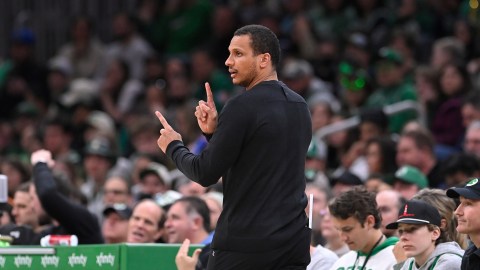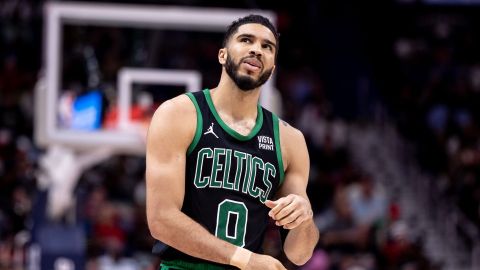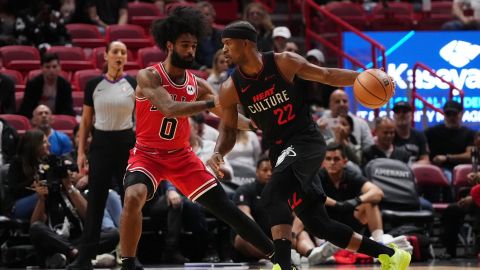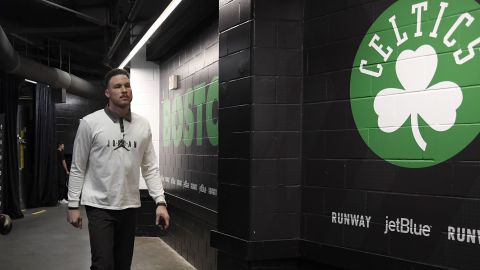 Most of the discussion related to Boston Celtics trades this offseason revolves around two things: Rajon Rondo and the team’s first lottery draft pick.
Most of the discussion related to Boston Celtics trades this offseason revolves around two things: Rajon Rondo and the team’s first lottery draft pick.
All the attention is justified. Their All-Star point guard and their lottery pick are the Celtics’ most cherished assets. Whatever president of basketball operations Danny Ainge chooses to do with them will has massive implications for the direction of the franchise’ ongoing rebuild.
Yet Rondo being the Celtics’ best player doesn’t mean he would be the easiest one to move if Ainge looks to really shake things up. No conversation about personnel in the NBA can ever be had without considering the contract and payroll implications, as well as the age and health of the players in question.
Here is a quick primer on the Celtics’ roster flexibility, ranked from most movable to least movable. We omitted unrestricted free agents, such as Kris Humphries and Jerryd Bayless, as well as players who technically do have contracts next season but have virtually no trade value, like Chris Johnson and Vitor Faverani.
All contract information comes courtesy of ShamSports.
Avery Bradley and Phil Pressey — This is sort of cheating, but if you ain’t cheating, you ain’t trying, right? Bradley is a restricted free agent, with the Celtics holding the right to match any offer he receives. If the Celtics aren’t interested in keeping Bradley around, they can simply decline to tender him an offer. Pressey has two more seasons at less than $1 million each, but both are non-guaranteed, meaning the Celtics could cut him loose if they so desired. The same goes for Chris Babb and Chris Johnson.
Jared Sullinger — As for players who are actually on guaranteed contracts, Sullinger would be the easiest to find a trade partner for. The promising 22-year-old increased his averages to 13.3 points and 8.1 rebounds this season, playing in 74 games despite offseason back surgery. He has promised to get into better shape this summer and is under team control through 2016, provided the Celtics exercise their $2.2 million option after next season. Parting ways with Sullinger would be difficult, but if he weren’t desirable, other teams wouldn’t be interested, either.
Rajon Rondo — He is a four-time All-Star, two-time assist champ and at 28 years old is just entering his prime. His $12.9 million contract for 2014-15 is relatively affordable, provided he is fully recovered from his torn ACL by next season. There might be a bear market for him, however, since Rondo appeared in just 30 games and has yet to prove he can play back-to-backs again. Ainge doesn’t want to sell low, which could be the biggest reason Rondo is still wearing green.
Brandon Bass — From experts and reactionary fans alike, Bass is the target of a lot of grief that is pretty difficult to understand. The estimable Ken Berger of CBS wrote about Bass “clogging up the Celtics’ cap room,” which is odd, since Bass will make less than $7 million in 2014-15 in the last season of his three-year, $19-million deal. That’s not chump change, but it’s hardly cap-clogging, either.
In fact, after Sullinger and Rondo, whom most teams would gladly take for the right price, Bass might be the most enticing Celtics player. Granted, that says more about the Celtics than it does of Bass, but we digress. He is undersized for a power forward, but that is less and less detrimental in a league that goes smaller every season. His ability to defend both forward positions and some new-school, smallish centers is of growing value.
Kelly Olynyk — Bass started 73 games this season, but he ideally is not a starting player. Still, he gets ranked ahead of Kelly Olynyk for the simple fact that teams know Bass can play. Olynyk, for all his bright spots as a rookie, still needs to prove this at the NBA level.
Which version of Olynyk is real? Is he the lost puppy who for most of the season looked like it was his first day on his new legs? Or is he the confident, capable stretch-forward who averaged 25.7 points in the final three games? Olynyk is not expensive (he won’t crack $3 million in salary until 2016-17) but it will take a lot more than three good games for a team to offer the Celtics anything of real value for him.
Jeff Green — Three years into his Boston tenure, Green remains an enigma. He is so talented, so physically gifted, and yet it seems as though he never learned some of the most basic elements of the game, and now figures it is too late to try. A report that the Washington Wizards have “long liked” Green and could target him in a trade should have been met with glee from Celtics’ fandom.
Instead, the reaction was mostly shock that any team is still interested in the 27-year-old forward. Green has two years and more than $18 million left on his contract, and on the cusp of his prime, he is what he is. Maybe there is a mid-career bloom inside of him somewhere, but if you had to put money on it, which way would you bet?
Gerald Wallace — Wallace is the ultimate trade tease. Throw him into the ESPN Trade Machine and anything is possible.
Of course, we don’t have to tell you the chance of any of these trades happening is roughly the same as Larry Bird getting knee and back implants, coming out of retirement and winning the dunk contest.
Wallace is the closest thing Ainge and the Celtics have to an unmovable object, and the greatest evidence that this turnaround won’t be as quick as some fans believe or hope. Wallace has two more seasons at more than $10.1 million apiece remaining on his contract. It is hard to imagine any enticement that would convince another team to take Wallace. Perhaps if Wallace were packaged with the No. 1 overall pick, since the trade partner would be primed for two years of grooming its young star, or maybe — no. Now we’re just grasping.
Despite some unwieldy contracts, the Celtics are in fine shape financially. They avoided the luxury tax this season and could be below the salary cap next season with the right roster finagling. That in itself is a credit to the work Ainge did last summer.
Being in good shape doesn’t mean there aren’t obstacles, though. Ainge’s goal at the end of the Paul Pierce era was to make sure the franchise wasn’t completely hosed from a talent and economic standpoint. In that much, at least, he succeeded.






